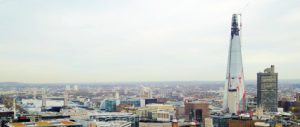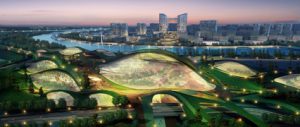At the start of the industrial revolution, people were scarce and resources were abundant. Today, the opposite is the case: we have a burgeoning population and dwindling resources. This shift, along with the growing challenge of climate change, suggests that we should develop design approaches that use fewer physical materials and more human resources.
Biomimicry achieves radical reductions in energy, uses physical resources sparingly and offers the potential for greater human input in terms of design and manufacturing ingenuity. It aims to draw the best out of biology, learning from products that have benefited from 3.8 billion years of research and development. Living organisms, because of the ruthless refinement process of evolution, are remarkable models of efficiency.
Some of the most inspiring examples in nature can be found where evolutionary pressures have selected particularly strongly for one factor. Birds, for example, have evolved in response to intense selective pressure on weight. The skulls of ordinary songbirds, such as crows and magpies, are little short of engineering miracles. A magnified cross-section shows that they comprise multiple bony shells that are connected by a matrix of ties and struts: an astounding combination of shell action with space-frame technology. Their thick skulls afford them maximum protection, while their weight remains as low as possible.
Spiders make their silk with spinnerets that produce a stream of perfectly aligned protein polymers. The strands are “spun” into a thread with the spider’s back legs and, when dry, the silk is stronger than Kevlar, the strongest synthetic fibre that we have been able to manufacture to date. The contrast in manufacturing methods is profound. Making Kevlar involves extremes of temperature and pressure, and produces large quantities of toxic waste, yet spiders achieve the same result at ambient temperature and pressure, using only dead flies and water.
This example is far from exceptional. Our manufacturing methods typically start with energy-intensive mining, crushing, smelting, refining and forming. The process frequently continues with other stages of treatments, protective coatings and adhesives. Natural sciences writer Janine Benyus refers to this as a “heat, beat and treat” mentality that compares unfavourably with the manufacturing that takes place in nature.
Until recently, it was difficult to mimic nature’s manufacturing processes because complexity of form nearly always resulted in higher cost. But we are now in the early stages of a digital manufacturing revolution. Rapid prototyping, which emerged in the 1980s, was a significant breakthrough for designers because it allowed them to turn a three-dimensional computer model into a physical one with a high degree of accuracy and minimal labour. The technology has developed consistently and has moved from a method for producing prototypes to one that may enable mass production.
While we have some way to go before achieving equivalent technology to biological growth processes, there is certainly the potential to use natural polymers such as cellulose to build complex, efficient structures at low temperature and ambient pressure. Imagine the implications of using materials made with 1% of the energy of conventional ones, in structures that are 10 times more efficient. Moreover, if we use them correctly, all of these materials can be recycled time and time again, in an endless process of transformation. The very notion of waste can be progressively designed out.
One of the best-known examples of biomimicry is the Eden Project [in the south-western English county of Cornwall], which took inspiration from pollen grains, radiolarian, carbon molecules and dragonfly wings to produce a radical reinterpretation of an established building type. The membrane covering was 1% of the weight and embodied energy of a glass solution. The end result was a superstructure lighter than the air contained within the building and the cost was a third of that of a conventional approach. With more advanced manufacturing technology, based on biology, the structure could be even more efficient in terms of resources.
The Sahara Forest Project is an initiative that aims to support agriculture in water-stressed parts of the world. It draws lessons from the fog-basking beetle, which has evolved to harvest fresh water in the desert. The project mimics ecosystems’ ability to create more value by designing out waste. In the near future, we may learn from jewel beetles, which make mirrored surfaces from proteins, from thorny devil lizards, which make water-harvesting surfaces, and from sand skinks, which swim through sand without suffering any abrasion.
While it could be argued that biomimicry has been used for centuries – the first dome structures were almost certainly inspired by shells – we now have an opportunity to revisit the idea of learning from biology with the massive advantages of scientific knowledge, better tools and aesthetic sensibilities unconstrained by historical dogma. It is rare for designers to be presented with such an opportunity.
So how can we accelerate these transformations? While there is a place for legal measures in some circumstances, fiscal measures that reward ingenuity are a surer way to stimulate innovation. Developments in computer-aided manufacturing to date have largely been driven by military research budgets. Addressing the paucity of research funding in the building industry would help to overcome a major barrier to innovation, enabling more companies to turn new ideas into commercial reality.
In evolution, some of the most remarkable adaptations have occurred in response to scarcity. We could stimulate innovation in an equivalent way by shifting taxation away from employment and towards the use of resources. On the Eden Project, for example, the cost of resources largely determined how efficiently they were used. If the price of steel had been higher, it would have made economic sense to use less of it. This would have saved resources and generated additional jobs through increased manufacturing complexity. Forms of environmental taxation, such as internalising climate-change costs in resource prices, would stimulate innovation and save resources.
Too often, governments try to bring about change through mandate rather than by creating the economic conditions out of which innovation can emerge. The latter approach would effectively be identical to the process of evolutionary refinement. In nature, materials have always been expensive and the result is a catalogue of solutions that achieve efficiencies several orders of magnitude higher than most human manufacturing.
Michael Pawlyn is the director of Exploration, a sustainable architecture practice based in London. His book, Biomimicry in Architecture, was published in 2011 by RIBA Publishing.
This article was first published in the winter 2011 issue of the RSA Journal, a publication of the London-based Royal Society for the Encouragement of Arts, Manufactures and Commerce (RSA), and is used here with permission. © The RSA.
Homepage image by Jürgen Matern of polymer domes emulating natural biomes at Britain’s Eden Project.



